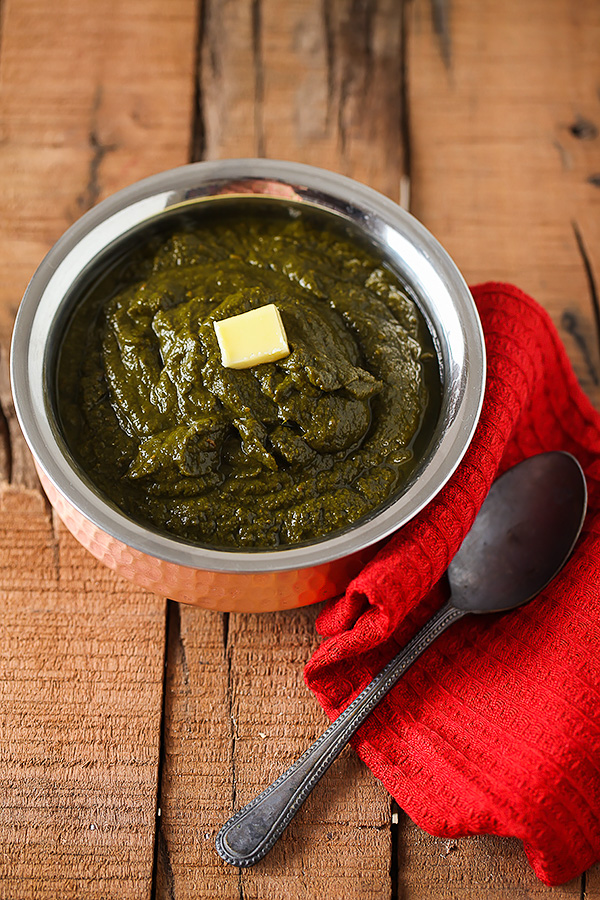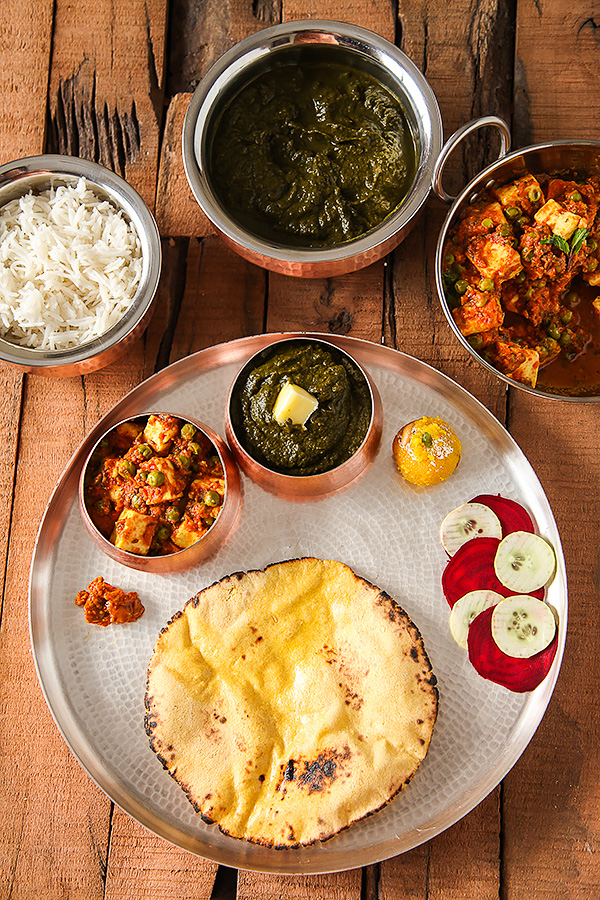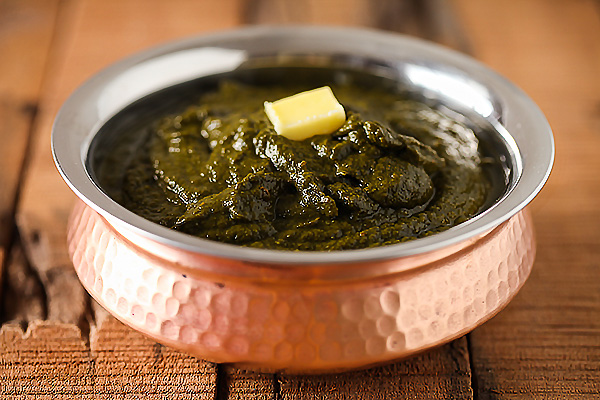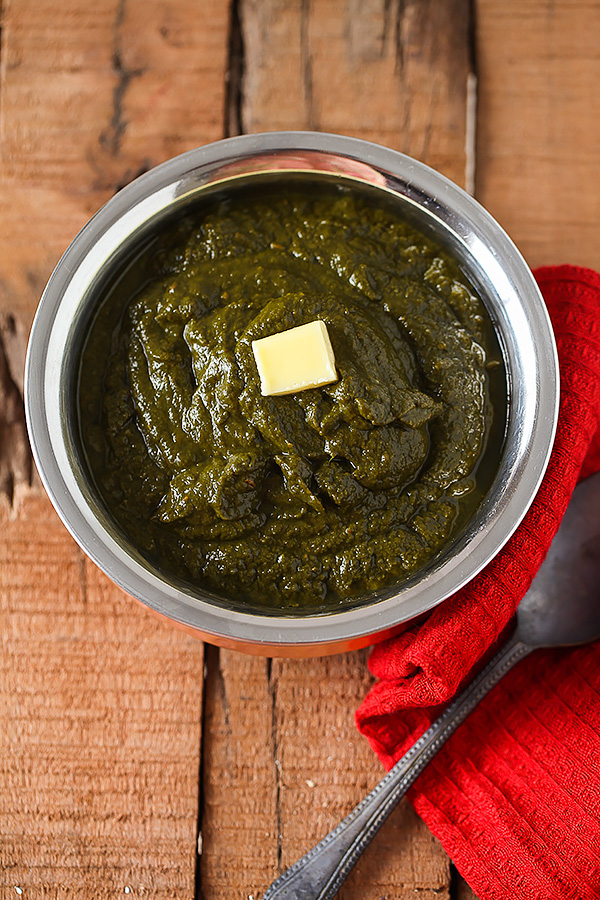
I first heard about sarson ka saag when my father ordered it in a Mumbai restaurant. Â During dinner, he then reminisced about the sarson ka saag he had relished on his travels to the northern parts of India like Delhi and Chandigarh and told us about how delicious this dish was and how the Punjabi folks revered it.
Growing up in South India, mustard leaves were quite unfamiliar to us, unlike the mustard seeds that went into practically every south Indian dish. I did hear about the mustard leaves or sarson travelling from the north in trucks to the Punjabi establishments in town. This was then made into sarson ka saag and relished in some Punjabi households of our city.
At the cost of sounding immodest, I would like to say that I have had very few disasters in my kitchen. Probably this fuels me to create more recipes. But when I tried making sarson ka saag for the first time at home, I wasn’t happy with the results. The dish turned out bitter and I wasn’t impressed at all. When I expressed this to one Punjabi aunty in our Mumbai building, she told me the secret to avert the bitterness in sarson ka saag. And this was to use bathua leaves and spinach leaves along with the mustard leaves.
Somehow, I never got to trying sarson ka saag again for many years after my first trial. Then, a year ago, my friend Sheenu sent me some sarson ka saag along with white makke ki roti and I loved it. This year she sent me sarson ka saag again and I was tempted to try the recipe. Sheenu uses shalgham or turnip in her saag recipe and while cooking for me she lovingly skipped the onion and garlic.
One fine winter afternoon, I decided to omit the shalgham and experiment with the fresh mustard, bathua and spinach that my vegetable vendor had sent. And I fell in love with the flavours in this dish so much that I cooked it many a time during the winter season. Mustard leaves are seasonal and are available only during the winters. According to Ayurveda mustard leaves are heating to the body and are best had during the winters.
Winter vegetables are always a treat to look at and to cook with- fresh, crisp, colorful and needless to say nutritious. The greens used in my Sarson Ka Saag recipe are loaded with nutritive, healing and healthful properties. When mustard leaves are not in season or if you cannot find bathua leaves, you can substitute this dish with other greens like spinach, radish greens, beet greens, kale, collard or sorrel.
From now on, come winter and Sarson Ka Saag along with Makki ki Roti will always adorn my kitchen fires.
Sarson Ka Saag
A curry made with mustard greens, other greens and spices.
Ingredients:
1 bunch mustard (sarson) leaves
1 bunch bathua leaves
1 bunch palak or spinach leaves
250 ml (1 cup) water
3 tomatoes, quartered
1 green chili
2 tsp fresh ginger
3 tbsp oil (preferably mustard oil)
¾ tsp cumin seeds
½ tsp asafetida powder
½ tsp turmeric powder
1 tbsp maize flour or gram flour
½ tsp red chili powder
1 ½ tsp salt or to taste
1 tbsp butter or ghee for garnish
Method:
Clean the leaves well, chop them roughly, place them in a pressure cooker add the water and pressure cook until 1 whistle. After the whistle allow the cooked leaves to cool completely and then blend them to a fine puree.
In a blender put in the tomatoes, ginger and green chili and blend to a fine puree.
In a wok or kadhai, heat the oil. One the oil is hot, put in the cumin seeds. After the cumin seeds change colour and turn golden, add the asafetida powder, turmeric powder and maize flour.
After the maize flour changes in colour, about about 40 to 50 seconds, put in the tomato puree and the red chili powder.
After the tomato puree is cooked and the oil begins to separate, add the pureed greens.
Stir in the salt and cook for 8 to 10 minutes more on low heat.
Serve with makka (maize flour) rotis or any other breads of your choice. This tastes great with plain basmati rice too.
Serves 4
Notes: When mustard leaves are not in season or if you cannot find bathua leaves, you can substitute this dish with other greens like spinach, radish greens, beet greens, kale, collard or sorrel.
To receive recipes, tips and inspiration that feeds your body, mind and soul subscribe to Divine Taste newsletter





Looks so nice creamy..
Wow….a new post after so long ….
But not very much excited about the recipes …because I'm using same ingredients… anyway keep posting.,
Good wishes and JSK
I don't knowif you are aware, but the traditional Punjabi Sarson ka saag does nOT use the leaves. The Saag is made out of the stalks, tender ones, & the thicked ones. The thicker ones are peeled to remove the very fibrous outer layer. Only VERY TENDER YOUNG LEAVES are used yin the saag. It is cookes till very tender, then smushed to a very smooth paste, the corn meal (maize flour) is added & the saag is cooked till the water is absorbed & the saag os smooth & silky. (the maize flour is the thickener toabsorb the water & make the saag very silky)
It is only before serving that the tadka (vaghar.baghar/chhonk)is added, so that the fragrance is fresh & divine & the ghee (that is what is used) is NOT absorbed in the saag & the flavor lost. It also kind of minimizes the amount of ghee used, although those who want, can add more in their own katori as they eat
Rumana- Great!
Mira- Sarson ka saag was a much requested recipe from many. At times a simple recipe can be so appealing and to many sarson ka saag is really exotic.
[…] Growing up in South India, mustard leaves were quite unfamiliar to us, unlike the mustard seeds that went into practically every south Indian dish. I did hear about the mustard leaves or sarson travelling from the north in trucks to the Punjabi establishments in town. This was then made into sarson ka … Continue Reading […]
thanks for sharing this recipe.
BookBaak.com
Mam aapne sarson ka saag banana bahut hi aasan kr Diya hai thanks for sharing this recipe.
I made this today after searching for Saatvik Sarson Ka Saag as we are trying to eliminate onion and garlic from our diet. The recipe turned out great! I had a lot of chard in the garden, so just used chard and lots of mustard greens from our garden.
We had it with whole wheat pita bread, with lemon juice sprinkled on it. We are vegans, so I used coconut oil and no dairy products at all.
Thanks so much for the recipe!
That's wonderful Veena. Thanks for the feedback!
Its my pleasure Seema!